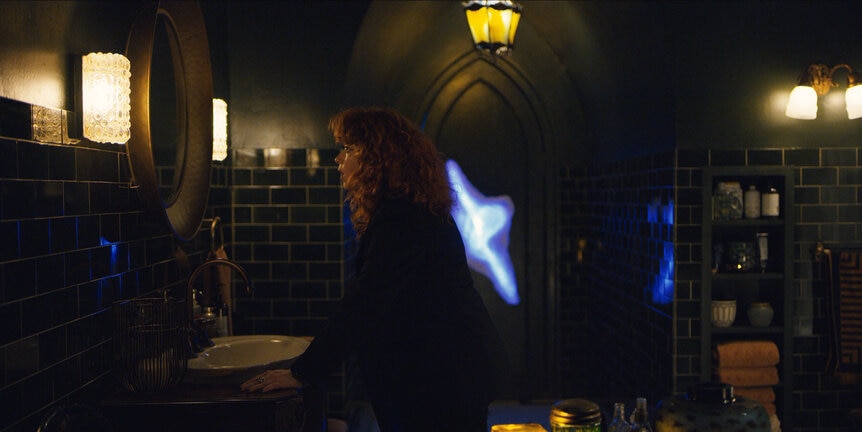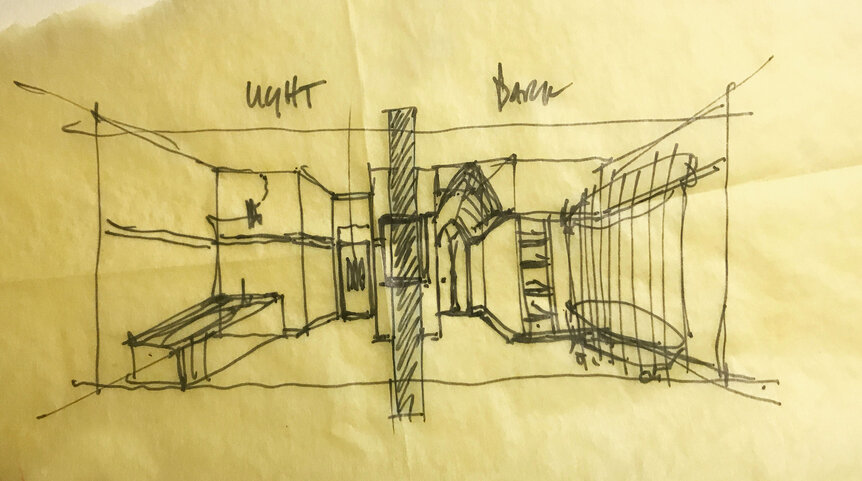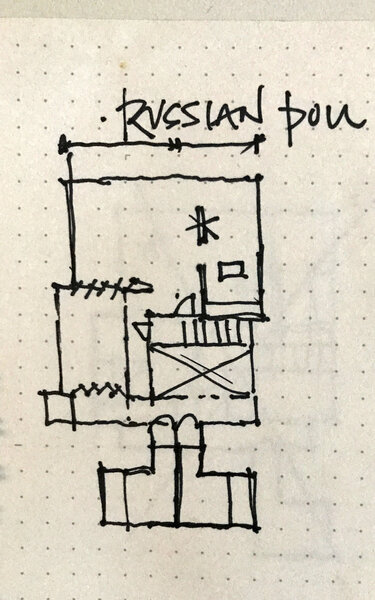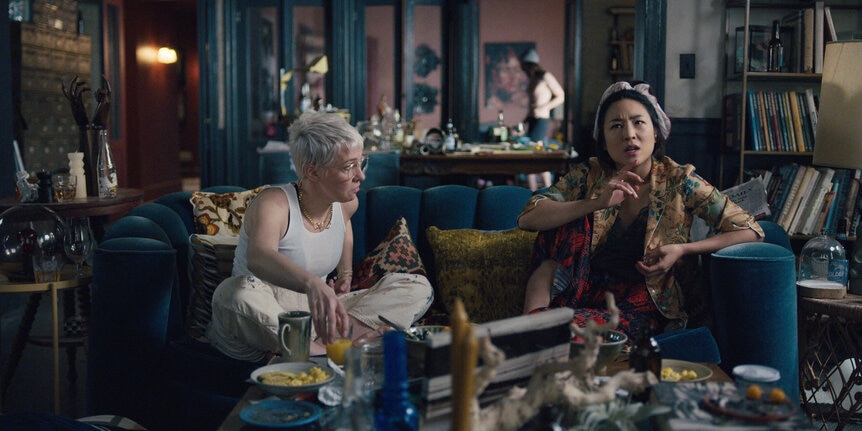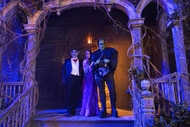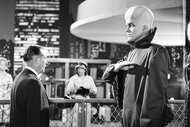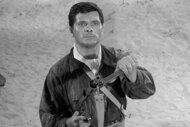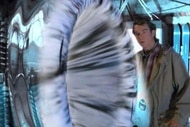Create a free profile to get unlimited access to exclusive videos, sweepstakes, and more!
Emmy Contender: A trip through Russian Doll's award-nominated bathrooms
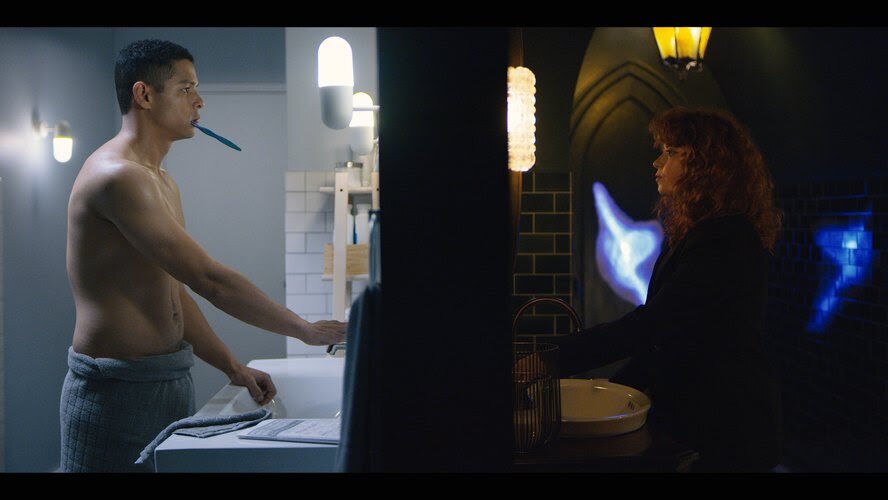
Welcome to Emmy Contenders 2019. This month, SYFY WIRE is speaking to a long list of actors, artists, and artisans whose work earned them Emmy nominations this year. Today, we speak with Michael Bricker, the Emmy-nominated production designer on Netflix's Russian Doll.
Like the nesting Matryoshka dolls that give the show its name, Russian Doll is a puzzle, a game that begins over and over again when its lead character, Nadia (Natasha Lyonne), goes into the bathroom of a friend’s loft where a birthday party is underway. She then dies... and then she’s reborn. There’s a strange, glowing blue shape embedded in the door of this bathroom that no one can figure out. “Geez, what is that?” wonders Alan (Charlie Barnett), who finds that, like Nadia, he is also dying and living again. “Is it vaginal enough?” asks Maxine (Greta Lee), the artist who helped design the piece.
That’s a key question. Nadia at one point theorizes that the shape is a dense gravitational field that has gained consciousness and is deliberately screwing with her. (If it were conscious, it very well could; the shape already creates an illusion in the bathroom’s dark green tile, appearing as it if were three shapes, not one.) But could it be connected to her transport through a metaphysical portal that bends space and time? Is a symbol of birth behind her rebirth? Pulling on the bathroom’s gun-shaped door handle and moving down a long tunnel-like hallway — inspired by the archway of a Gothic church — is the beginning of Nadia’s rabbit hole into Wonderland.
In the original script for Russian Doll, the shape on the door was described as a papier-mâché vagina, and Nadia’s emergence from it was supposed to signal a rebirth.
“I think we made it a lot less vaginal than it was in the script,” Emmy-nominated production designer Michael Bricker tells SYFY WIRE, laughing. “My inspiration was more galaxies and space — it’s supposed to read more like a nebula. I wanted it to be unclear. You see this glowing gash in the door, and you’re just like, ‘What is that?’ Hopefully, people feel like it will come back around in some way, even after the end of the series. ‘Was there something going on, or was it just a piece of art that Maxine made?’ The lack of clarity and tension is kind of cool.”
Something — however undefined — is going on with bathrooms in this show. Alan finds himself in his own bathroom after each death, as well. One of the most stylish shots in the series comes at the beginning of Episode 8 when it seems the two magical bathrooms exist side-by-side, almost as mirror images of each other. And in the real world outside the story, they do — the two bathrooms were built back-to-back onset so the camera could pan overhead as both Alan and Nadia stare into their respective mirrors (which seem more like portals by the end of the season than the shape in the door does).
“I was really excited when I learned we had the second bathroom, and another character resetting there,” Bricker says. “I liked the idea of these characters resetting and staring at themselves, and in the finale, in a way, they’re looking at each other as well as themselves."
The show’s concept borrows a lot from the world of video games — Nadia is a game developer — and Bricker helped develop this game’s rules. He designed Nadia’s bathroom so that there were a number of different options for leaving (rather like a Choose Your Own Adventure game). He also created the pathways as concentric rings, revealing that the world of Russian Doll is itself a maze, a nested Russian doll. (The maze concept is reflected in the title of Nadia’s own video game, The Legend of Ariadne.)
Bricker actually plotted the different locations of the show’s internal world on a cross-section of a Russian doll, mapping how the loft was the center of the doll — or the world — and it was surrounded by concentric rings. He marked how different parts of Nadia’s and Alan’s world — like their respective apartments — were equidistant from each other, and from Maxine’s loft. The farther away they get from that central position, the more desaturated the world becomes.
Once Bricker shared that strategy with the Russian Doll team, it became the blueprint for everything from blocking to tracking and even costuming.
“It helped establish the design as an anchoring force for the show,” he says. “It unlocked something for us as a tool for creating the world.”
Consequently, the first time Nadia exits the bathroom, she takes the longest path, or loop, through the loft apartment, winding through the bedroom, the dining room, the living room, and the kitchen, greeting party guests along the way. Each time she resets, she takes a shorter route — skipping the bedroom and going straight to the kitchen, going down through the hallway. Eventually, she just leaves out the front door. Meaningfully, until she meets Alan, Nadia always only turns to the right. Once she meets Alan at the elevator, though, she starts to turn left (for instance, going out the fire escape instead of the front door) as these two reincarnations begin to influence — or infect — each other’s gameplay.
“We really did think about these things,” Bricker explains. “There really was an intention behind them seeming like opposing forces."
Things begin to disappear on the show, subtly at first — cats and fish go missing, then animal-related artwork and objects with animal prints. Plants start to wilt and die, then fruit begins to rot — obviously, organic matter can’t survive in this weird world. Then larger objects like clocks, mirrors, furniture, and artwork begin to vanish as if some spectral repo man were at large in the loft. (This was a serious continuity challenge for set dressers Kara Haas and Michael Landman, as the show’s scenes were shooting out of order.)
The artwork we see — at least until it disappears — provides essential clues. Some of it was curated by Natasha Lyonne, including mixed media pieces by Brian Degraw, collages by Dash Snow, and two works by Lizzi Bougatsos: “Bunny” and “The King’s Virgin.” Other pieces displayed in the loft (selected by Bricker and set decorator Jessica Petruccelli) include “Without an Object” by Erica Wessmann, “Beach 12” by Meg Turner (in the bathroom), and “Girl in Pool” by Billy Feldman (above the fireplace). Many of these pieces were intended to foreshadow Nadia’s various deaths (such as “Girl in Pool” being a prediction of Nadia’s drowning).
“We intentionally had a lot of artwork with fractured faces, as well as faces looking back and faces looking directly at the viewer,” Bricker says. “My favorite piece is at the end of a long hallway — it’s a puzzle of a woman’s face [“Maria & Katarina,” by Alma Haser]. It looks like it was two different puzzles originally, but it’s been made into one, so all the pieces look like they’re in the wrong place. That was a real anchoring work of art — it was looking back, but it also looked like it was glitching."
Russian Doll’s loft and bathroom designs have spawned imitators (create your own!) and Bricker says he’s been “stunned” by the fan reaction. “This is the first TV series I’ve ever done,” he says, "and I’m shocked at all the love."
